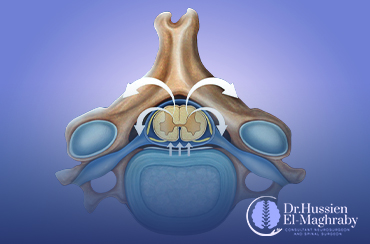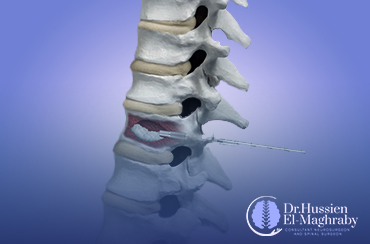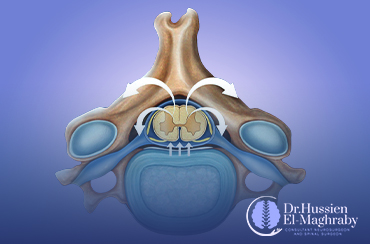
Spinal Decompression by 3D Printing and AI
The intersection of technology and healthcare creates pioneering solutions for complex conditions. One of these advancements is the treatment of spinal stenosis, a condition characterized by the narrowing of the spinal canal, which can lead to pain, numbness, and mobility issues. Traditional surgical methods have often been filled with uncertainties and risks. However, integrating 3D printing and artificial intelligence (AI) heralds a new era of precision and customization in spinal surgeries. Thanks to the efforts of Dr. Hussien El-Maghraby; Consultant Neurosurgeon and Spinal Surgeon at University Hospitals Coventry and Warwickshire NHS Trust, England, United Kingdom, this technique has become available for the first time in Egypt, offering patients the opportunity to receive exceptional care.
What is the neural canal?
• The neural canal, also known as the spinal cavity or spinal canal, is the tunnel that runs through each vertebra of the spine. This canal houses a crucial part of the central nervous system, the spinal cord, and the spinal nerve roots that branch off from it in pairs. The neural canal plays a vital role in protecting the spinal cord, allowing it to extend through the spine and supply nerves throughout the body.• The spinal cord is made up of spinal nerves that transmit signals from the brain to the rest of the body. The surrounding bones and tissues protect these nerves. However, if the spinal nerves are damaged, it can negatively impact the patient's ability to perform daily activities.
What is spinal stenosis?
• Spinal stenosis is a condition in which the spaces within the spine narrow, leading to pressure on the spinal cord. This process is often gradual and can occur in any part of the spine.• If the narrowing is minimal, there may be no symptoms. However, if the narrowing is significant, it can lead to back pain and other neurological disorders, such as nerve and spinal cord injury or damage, making treatment difficult even with surgery.
Types of spinal stenosis:
There are several types of spinal stenosis, including:1-Lumbar spinal stenosis:
Lumbar spinal stenosis refers to a condition in the back that primarily affects the legs. This narrowing occurs around the spine that contains the nerves or spinal cord, impacting the lower back. This can lead to irritation or compression of the nerves extending into the legs. Potential symptoms of this condition include:
• Low back pain.
• Pain that starts in the buttocks and radiates down the leg.
• Pain in the foot.
• A feeling of heaviness in the legs can lead to cramping in one or both legs.
• Numbness or tingling in the lower body.
• Pain that worsens with walking or physical activity.
• Pain decreases when you bend forward, walk uphill, or sit down.
2-Cervical spinal stenosis:
The narrowing of the spinal canal that occurs in the part of the spine located in the neck is also referred to as cervical spinal canal stenosis.Common symptoms of cervical spinal stenosis include:
• Neck pain.
• Pain in the arms.
• A tingling sensation that radiates to the lower back when moving the head.
• Disturbances in balance.
• Numbness in the arms or hands.
• Decreased function of the hands, such as difficulty writing.
Causes of spinal stenosis:
• Many changes, such as osteoarthritis or various spinal injuries, can lead to spinal stenosis.• One of the most common causes of spinal stenosis is aging. As people age, especially after the age of 50, these conditions typically occur due to injuries or changes in the spine that happen with aging, known as degenerative changes. The tissues in the spine begin to thicken, and the bones may enlarge, leading to the formation of bone spurs, which puts pressure on the nerves.
Diagnosis of spinal stenosis:
The diagnosis includes examining the medical history, conducting a physical examination, and observing movements. Among other tests used are:• X-rays of the spine: X-rays reveal changes in bone structure. For example, they can show loss of height in the intervertebral discs, which are responsible for bearing pressure and shocks to protect the vertebrae, or the appearance of bone spurs.
• Magnetic Resonance Imaging (MRI): MRI uses certain waves to create cross-sectional images of the spine. MRI provides detailed images of the nerves and spinal cord.
• Computed Tomography (CT scan): It is a combination of X-rays that create cross-sectional images of the spine. CT scan can be used with contrast dye to view the spinal cord and nerves more clearly.
Dr. Hussien El-Maghraby uses the latest global techniques to diagnose and stage spinal stenosis, as well as to accurately identify the affected vertebrae.
Treatment of spinal stenosis:
There are several methods available for treating spinal stenosis. The treatment approach is determined by the stage of the stenosis, the severity of pain, its location, and its impact on daily activities. Some of the effective treatments include:1- Surgical intervention through spinal decompression procedures to widen the spinal stenosis:
These surgical interventions aim to widen the stenosis in the spinal canal. In the past, a surgical opening was made to remove the bony area of the vertebrae that was causing pressure on the spinal cord, to expand the spinal canal, and then those vertebrae were stabilized using screws and surgical plates. However, this surgery is associated with many complications, the most notable of which are:• The occurrence of damage in the spinal canal and spinal cord due to the incorrect angling of screws and plates, which may lead to paralysis or foot weakness.
• The need for follow-up surgery to remove those screws and metal plates.
2- Spinal decompression procedures using artificial intelligence and 3D printing:
Dr. Hussien El-Maghraby is distinguished by introducing a new technique for treating spinal stenosis, the first of its kind in Egypt. This technique relies on widening the spinal canal using artificial intelligence and 3D printing. Dr. Hussien El-Maghraby does the following:1- Conducting precise CT imaging of the affected vertebrae, which provides significant benefits by offering accurate anatomical details of the spine for each patient. The shape of the vertebrae varies from patient to patient based on multiple factors, such as obesity or the presence of spinal degeneration. This information contributes to enhancing the chances of surgical success when stabilizing the screws and metal plates and reduces the risk of damage to the spinal cord and surrounding nerves.
2- Dr. Hussien El-Maghraby uses artificial intelligence to create an accurate pathway for the screws used in stabilizing the vertebrae before the surgery is performed. This procedure aims to ensure the correct placement of the screws, helping to avoid potential complications and increasing the safety of the procedure.
3- Dr. Hussien El-Maghraby uses 3D printing to create a model of the spine, as well as a tangible guide used for placing the screws and metal plates in their correct positions. During the surgery, this guiding model is customized for the vertebra to be stabilized and is specifically prepared for each patient. This technique ensures the success of the surgical procedure and reduces the risks of nerve and spinal cord damage.
4- During the procedure, the spinal canal is widened by removing the bony area. After sterilizing the models used as guidance during the surgery, the vertebrae are stabilized to ensure that the stenosis does not recur.
Advantages of spinal decompression procedures using artificial intelligence and 3D printing:
1- This procedure ensures that there is no nerve damage that could lead to paralysis, unlike traditional procedures.2- Treatment with this modern technique has become a safe and effective procedure that helps patients lead better daily lives.
3- The customized 3D printing procedure for each patient before the surgical intervention allows for an accurate view of the vertebrae, helping to overcome anatomical differences among patients. This enhances the assurance of the procedure's success and reduces the likelihood of any complications.
Modern technologies contribute to reducing the occurrence of complications, giving patients the opportunity to undergo modified surgeries that are effective and have fewer complications. Thanks to the expertise of Dr. Hussien El-Maghraby; Consultant Neurosurgeon and Spinal Surgeon at University Hospitals Coventry and Warwickshire NHS Trust, England, United Kingdom, along with his extensive experience in utilizing modern techniques and exceptional surgical skills, patients are assured of achieving the best outcomes in the treatment of spinal stenosis without complications. Now, for the first time in Egypt, patients can undergo spinal decompression surgery using the latest global technologies. Don’t hesitate to get your consultation now.
شارك:
خدماتنا

الحقن الأسمنتي للفقرات
يتم علاج هشاشة العظام وكسور العمود الفقري بالتدخل الجراحي المحدود وحقن الأسمنت الطبي.

تبخير الغضروف بالليزر بدون جراحة
علاج الانزلاق الغضروفي القطني والعنقي في دقائق، بالتدخل الجراحي المحدود بالليزر، لتبخير الغضروف الضاغط على العصب بدون ألم.

توسيع القناة العصبية بتقنية (3D Print) والذكاء الاصطناعي
يتم توسيع القناة العصبية القطنية والعنقية وتركيب المسامير والشرائح باستخدام الذكاء الاصطناعي AI والطبع بالبعد الثلاثي 3D Print.

